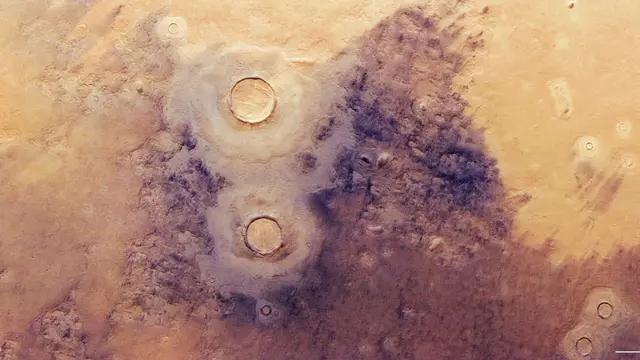China’s Zhurong rover has made a remarkable discovery in Mars’ Utopia Planitia, uncovering evidence of what appears to be a coastline from a now-vanished ancient ocean.
This finding significantly supports theories about Mars’ watery past, indicating that the Red Planet was once home to a substantial body of water.

The rover, part of China’s Tianwen-1 mission, landed in Utopia Planitia — a region suspected of having a watery history — back in 2021.
Although the rover went dormant in May 2022 due to harsh Martian conditions, the data it gathered has offered invaluable insights.
Researchers from Hong Kong Polytechnic University, the China Academy of Space Technology, and the Russian Academy of Sciences analyzed the data, revealing intriguing features in the area where the rover landed.
Among these features were pitted cones, polygonal troughs, and etched flows, all pointing to the presence of liquid water or ice at some point in the region’s history.

These landforms are typically associated with mud volcanoes, which often form in water or ice-rich environments, providing further evidence of past water activity.
The team utilized both remote sensing and in-situ data to identify sedimentary deposits and subsurface layers indicative of ancient marine processes.
This study proposes that around 3.5 billion years ago, an ancient ocean deposited rocks on Mars’ surface.
Initially, this ocean was likely frozen, and over the next 230 million years, it gradually receded, eventually disappearing, a process corroborated by the presence of sedimentary and layered rock formations.
Dividing Utopia Planitia into three zones of varied depths — shoreline, shallow sea, and deep marine — researchers were able to strengthen the theory of an ancient sea that once covered the northern lowlands of Mars.
The discovery of these water-related features provides compelling evidence of past water activities in the region.
According to Professor Wu Bo, lead author and spatial science expert from Hong Kong Polytechnic University, the rover’s data suggests that Utopia Planitia shifted from a water-rich landscape to a more arid one over billions of years.
The initial flooding of the area is estimated to have occurred around 3.68 billion years ago, with subsurface volatiles gradually dissipating over time, leading to the environment’s eventual drying.
The findings offer a potential explanation for how this ancient ocean was formed and evolved over time.
The research team plans to further investigate these features to estimate the depths of the marine environment and validate their model of Martian water history.
NASA’s Viking 2 mission previously explored Mars’ Utopia Planitia in 1976, leading to longstanding speculations about a once-existing ocean in the Martian northern lowlands.
With this new evidence from Zhurong, scientists gain stronger insights into Mars’ early climate and atmospheric conditions influenced by water, paving the way for future exploration and study.
